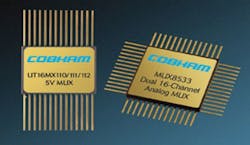NASA chooses radiation-tolerant multiplexers from Cobham for a variety of space applications
Officials of the NASA Shared Services Center (NSSC) at the NASA Stennis Space Center near Bay St. Louis, Miss., announced plans Tuesday to issue a sole-source contract to Cobham for flight Aeroflex multiplexers, part numbers 8511-201-1S and 8512-201-1S. The value of the upcoming contract has yet to be negotiated.
An electronic multiplexer makes it possible for several signals to share one device or resource like an A/D converter or communications line, instead of designing with one device per input signal. It selects one of several analog or digital input signals and forwards to one. line.
Spacecraft designers use radiation-tolerant multiplexers generally to increase the amount of data that can flow over a network within a certain amount of time and bandwidth.
Related: MRAM-based radiation hardened non-volatile memory products for space introduced by Cobham
The Cobham ACT8511 64-channel analog multiplexer module is radiation tolerant and protected from electrostatic discharge (ESD). It offers 64 channels provided by four 16-channel multiplexers; resists 150 kilorads of total-dose radiation; offers single-event upset resistance of 90 MeV-cm2/mg, and is single-event latchup immune by process design.
The ACT8511 is designed to meet exposure to radiation environments, and comes in a 96-lead high temperature co-fired ceramic (HTCC) quad flatpack (CQFP) package. It operates over the full military temperature range from -55 to 125 degrees Celsius, and meets MIL-PRF-38534 for demanding military and space applications.
The Cobham ACT8512, meanwhile, also is designed to meet exposure to radiation environments, and comes in a 96-lead HTCC CQFP package. It operates over the full military temperature range of -55 to 125 degrees Celsius, is screened to MIL-PRF-38534, and is for demanding military and space applications.
The Cobham ACT8512 48-channel analog multiplexer module offers 48 channels from six 16-channel multiplexers. It resists 150 kilorads of total-dose radiation; offers single-event upset resistance 90 MeV-cm2/mg, and is single-event latchup immune by process design.
The ACT8512 consumes 90 milliwatts of power, and has one address bus and three enable lines. The device has a 500-nanosecond access time.
NASA officials have determined that Cobham is the sole provider of these electronic parts. companies whose experts believe they could offer parts with similar performance should email NASA's Philip Pearson no later than 1 p.m. on Thursday 8 June 2017 at [email protected].
More information on this upcoming contract is online at https://www.fbo.gov/notices/ebf26260a5bd028b95fe53b2780ad577.
For additional information contact Cobham Semiconductor Solutions online at http://ams.aeroflex.com, or the NASA Shared Services Center at www.nssc.nasa.gov.
Learn more: search the Aerospace & Defense Buyer's Guide for companies, new products, press releases, and videos
